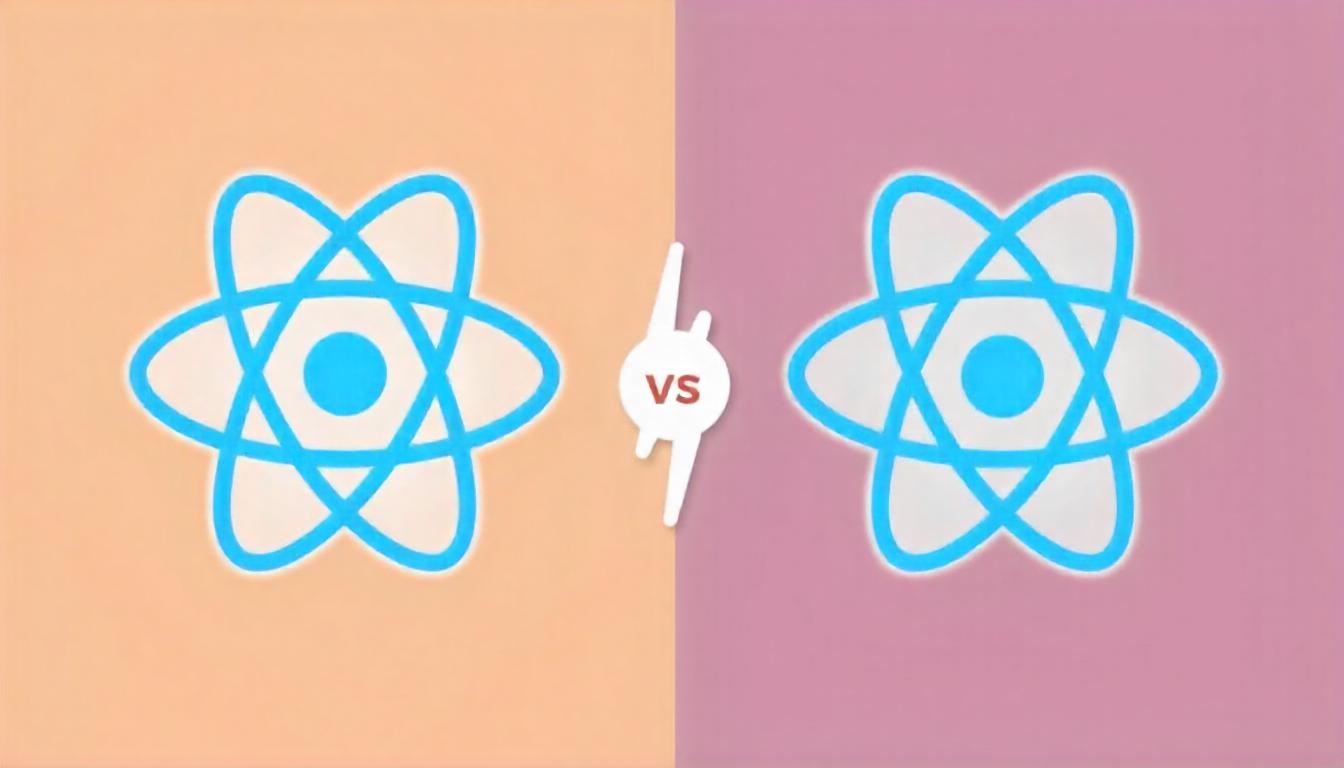
Key Differences Between React and React Native
Choosing the right tools for web and mobile app development is crucial. Among the myriad of options available, React and React Native stand out as popular choices. Both are products of Facebook and share similar principles, but they serve different purposes. In this blog post, we will delve deep into the differences between React and React Native, exploring their functionalities, use cases, and why many businesses choose to partner with a React Native app development company or a hybrid app development company.
What is React?
React is a JavaScript library used for building user interfaces, particularly single-page applications where you want a seamless user experience. Developed by Facebook, it allows developers to create reusable UI components, which helps in managing the state of an application efficiently. The core philosophy of React revolves around the virtual DOM, which optimizes rendering by minimizing direct manipulations to the real DOM.
Key Features of React
-
Component-Based Architecture: React encourages developers to break down UI elements into reusable components, making the code modular and easier to maintain.
-
Declarative UI: React allows developers to describe how the UI should look for a given state, simplifying the development process.
-
Virtual DOM: React uses a virtual representation of the DOM to optimize updates, leading to improved performance.
-
Ecosystem: React has a rich ecosystem, including tools like Redux for state management, React Router for routing, and a variety of libraries that extend its functionality.
-
Cross-Platform Support: While primarily a web technology, React can also be used in conjunction with other tools for mobile app development.
What is React Native?
React Native is a framework that allows developers to build mobile applications using React. While it shares many concepts with React, React Native focuses on delivering a native mobile experience. Instead of using web components, React Native renders using native components, giving apps a more authentic feel compared to those built with traditional web technologies.
Key Features of React Native
-
Native Components: React Native uses native components rather than web components, which means the apps have a look and feel that is consistent with other native applications.
-
Hot Reloading: This feature allows developers to see changes in real time without recompiling the entire app, enhancing productivity.
-
Cross-Platform Development: React Native allows developers to write code once and deploy it on both iOS and Android platforms, which can significantly reduce development time and costs.
-
Community and Libraries: React Native has a vibrant community and an extensive collection of libraries, which simplifies the development process.
-
Integration with Native Code: For performance-critical applications, developers can write some parts of the application in native languages (like Swift, Objective-C, Java, or Kotlin) and seamlessly integrate them with React Native components.
Key Differences Between React and React Native
While React and React Native share foundational principles, there are significant differences between the two that dictate their usage. Understanding these differences is crucial for developers and businesses alike.
1. Purpose and Use Cases
-
React: Primarily used for building web applications. It’s an excellent choice for single-page applications (SPAs) where user interaction is a key focus. Companies looking to enhance their web presence often turn to a React development company for tailored solutions.
-
React Native: Designed for building mobile applications. Companies seeking to develop a mobile application that runs on both iOS and Android often engage a React Native app development company to leverage its cross-platform capabilities.
2. Rendering and Components
-
React: Uses HTML tags and a virtual DOM to render components. Developers write JSX, which gets compiled to HTML and rendered in the browser.
-
React Native: Does not use HTML or CSS. Instead, it employs native components specific to mobile platforms (e.g.,
,,). This distinction is critical for creating applications that behave like native apps.
3. Performance
-
React: Performance is generally good for web applications but can be affected by complex state management and a larger DOM.
-
React Native: Offers better performance for mobile applications since it communicates with native APIs directly and uses native rendering.
4. Development Environment
-
React: Typically uses a web development environment. Developers use tools like Webpack, Babel, and npm to set up their projects.
-
React Native: Requires a mobile development environment, including Xcode for iOS development and Android Studio for Android development. This difference can influence the choice of a development company based on their expertise.
5. User Experience
-
React: Offers a web-centric user experience. The layout and performance depend on the web browser.
-
React Native: Provides a more fluid and responsive user experience typical of native applications. This is crucial for mobile app development, as users expect high performance and responsiveness.
Why Choose a React Native App Development Company?
As businesses navigate the complex landscape of mobile app development, many choose to partner with a React Native app development company. Here are some compelling reasons why:
1. Cross-Platform Efficiency
One of the primary advantages of React Native is its ability to allow developers to write a single codebase for both iOS and Android. This significantly reduces the time and resources required for development, making it an appealing option for startups and established businesses alike.
2. Faster Time-to-Market
By leveraging reusable components and the ability to share code across platforms, React Native accelerates the development process. Companies looking to enter the market quickly can benefit from this speed, making it a smart choice for competitive industries.
3. Cost-Effective Solutions
Developing two separate apps for iOS and Android can be expensive. By opting for React Native, businesses can cut down on development costs while still delivering a high-quality product. This is particularly advantageous for startups with limited budgets.
4. Access to a Large Talent Pool
As React and React Native have gained popularity, a large community of developers has emerged. This means companies can easily find skilled developers who are familiar with the frameworks, ensuring a smooth development process.
5. Robust Community and Ecosystem
React Native benefits from a strong community and a wealth of libraries, making it easier for developers to find solutions to common challenges. This support can lead to higher-quality applications and quicker troubleshooting.
Why Choose a Hybrid App Development Company?
A hybrid app development company offers another avenue for businesses looking to enter the mobile app market. Hybrid apps combine elements of both web and native applications, providing unique advantages:
1. Wider Reach
Hybrid apps can run on multiple platforms, including web browsers, iOS, and Android, providing businesses with a broader audience reach. This flexibility is crucial for companies looking to maximize their user base.
2. Lower Development Costs
Similar to React Native, hybrid app development allows companies to write a single codebase for multiple platforms, which reduces development costs. This is especially beneficial for businesses that want to launch an MVP (Minimum Viable Product) quickly.
3. Easier Maintenance
Maintaining one codebase for multiple platforms simplifies updates and bug fixes. This efficiency is a major draw for companies seeking to streamline their development and maintenance processes.
4. Faster Development Cycle
Hybrid apps can be developed more quickly than traditional native apps, allowing businesses to respond rapidly to market changes or user feedback.
Choosing Between React, React Native, and Hybrid Development
When deciding between React, React Native, and hybrid development, several factors come into play:
-
Target Platform: If your goal is to develop a web application, React is the clear choice. For mobile applications, consider React Native or hybrid development based on your target audience.
-
Budget and Resources: Assess your budget and available resources. If you’re looking to save on costs and development time, React Native or hybrid development might be the best options.
-
User Experience: If providing a native-like experience is crucial, React Native should be your go-to. However, if you are okay with a web experience, then React or hybrid could suffice.
-
Long-term Goals: Consider your long-term goals for the application. If you plan to expand into mobile later, starting with React Native could be beneficial.
Conclusion
React and React Native are powerful tools for web and mobile app development, each with its unique strengths and applications. Understanding the differences between the two is vital for businesses aiming to create effective and engaging applications. Whether you choose to work with a React Native app development company or a hybrid app development company, the right choice will depend on your specific needs, budget, and long-term goals.
By leveraging the capabilities of React and React Native, businesses can develop high-quality applications that meet user expectations and stand out in today’s competitive digital landscape. As you navigate your development journey, consider the advantages each technology offers and how they align with your business objectives.
















 Whatsapp
Whatsapp
 Email
Email


